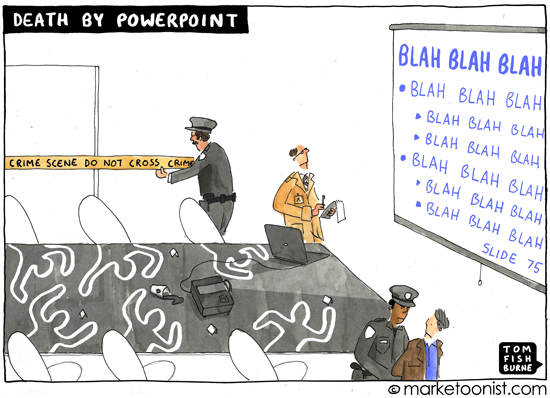Do you feel overwhelmed when presenting your business strategy to your board? Here are three tips for nailing your next strategy presentation, whether you’re preparing for a board meeting or a meeting with your CEO.
It’s a day before the Big Meeting, you’re pacing your (home) office at 7 pm, thinking about which points you want to make to show not only that the current business is sound under your management, but that you’ve got the right growth initiatives to accelerate revenue growth. Your team has prepared a 90-page strategy deck through rigorous analysis to prioritize the best growth options for the next three to five years, yet none of it will see the light of day if you don’t get directors excited about your business strategy. You’re not alone.
I’ve spent a good part of my 20+ year career building digital businesses, so I think a lot about how to effectively sell in new ideas. As a business strategy consultant, I now work with CEOs and Chief Strategy Officers of Fortune 300 companies through the strategic planning process from formulation to the implementation kick-off. Here’s how I prepare them to nail their business strategy presentation to their board with three important steps. I call them my KIT for Business Strategy Board Presentations.
- Keep it Simple – Your goal is to translate complex information into a clear and persuasive narrative. While easier said than done, start with telling your audience the ‘answer,’ tell them what led you to this conclusion, and support your ‘why’ with data and proof points. Present no more than 10 slides. Include everything else in the appendix.
- (Make it) Interactive – Yes, I took some liberty here using the “I” because, well, KIT is easier to remember than KMT. My point here is that board members are very smart and they get bored easily. They want to hear fresh insights and they want to contribute to the company’s success with their expertise. Go out of your way to include interesting content in your presentation.
- Tackle the most strategic question – While your deck may cover your entire long-term strategic plan, it would be a mistake to try and present all aspects during a 90–minute strategy discussion. Instead, focus the conversation on the main strategic question your new strategy solves and provide ways for board members to truly have a meaningful discussion about the strategy.
- Bonus tip! Read on for the one reminder I always, always suggest but most people forget to do.
Let’s unpack what’s in our KIT for strategy board presentations.
Step #1: Keep it simple
Start by solving for what a successful outcome looks like coming out of the board meeting.
Ask yourself:
- What do I want to accomplish in the meeting?
- What data and stories will I share to convince them?
- What are board members most concerned about? Which of these concerns can I best address today?
Focus your presentation narrative on answering these three questions well for your audience.
I have found that structuring your narrative in the following way remains the most persuasive approach: 1) State your ‘answer’ (your top strategy recommendations) → 2) why and how you came to this answer and → 3) support the why and how with data and facts. This is sometimes referred to as the Pyramid Principle first coined by Barbara Minto.
Step #2: Make it Interactive (and Interesting!)
We’re often so focused on getting through our “why and how” in the presentation that we forget the “show, don’t tell” golden rule of great storytelling. Sprinkle interactive elements such as consumer research interview videos, a live Mentimeter poll when the audience is larger than 10 people, or provocative content such as quotes from real buy-side investors, research analysts, or competitors.
Here are a few compelling supporting facts that work better than charts and figures alone.
- Voice of the customer: Instead of listing out consumer needs, play video snippets from focus groups or include screen quotes from social media
- Competitive landscape: Use public quotes from competitors talking about their strategy and new products
- Your company’s strengths and weaknesses: Include real quotes from employees, institutional investors, or retail shareholders
Step #3: Tackle the most important business strategy question
Frame the discussion by stating one central strategic question you and your team have been focused on solving, as opposed to presenting the entire plan. Assuming board members received the deck ahead of time, they would have already reviewed the executive summary, so there’s no need to cover again.
For example, say your company makes ultra-fancy yet comfortable socks and your sales went through the roof during the pandemic.
Instead of stating the question as: “How do we grow net sales above 15% for the next three to five years?,” you might frame the board discussion as follows: “In order to continue growing net sales north of 15%, we must grow our share within both men and kids categories. Today, let’s focus on how we might appeal to more men within brand X. Do you agree this is the right strategic question we should solve for? Are there other questions you think are important for us to answer?”
This shifts the discussion away from “I agree / disagree with your strategy” to “Yes, you’re addressing the right question, let me contribute my ideas and thoughts to your strategy process.”
Bonus tip: Practice, practice, practice
With last-minute analysis and drive-by questions coming at you leading up to the board meeting, we often forget to schedule a time to rehearse. Yet, this is the best way to nail your presentation, really. Schedule rehearsal time on your calendar weeks ahead so you take it seriously. Even better, practice with all other speakers. At a minimum, share your slides with each other in advance so you can align on speaker transitions and catch contradicting information before the big day.
Learn more about how I help clients in strategy here.

